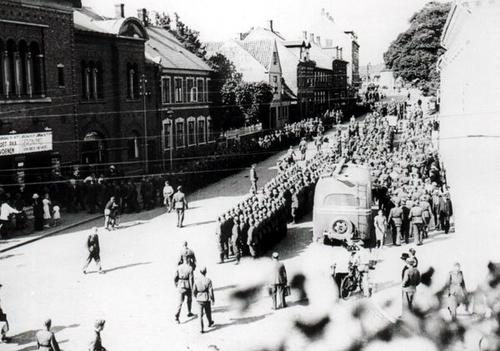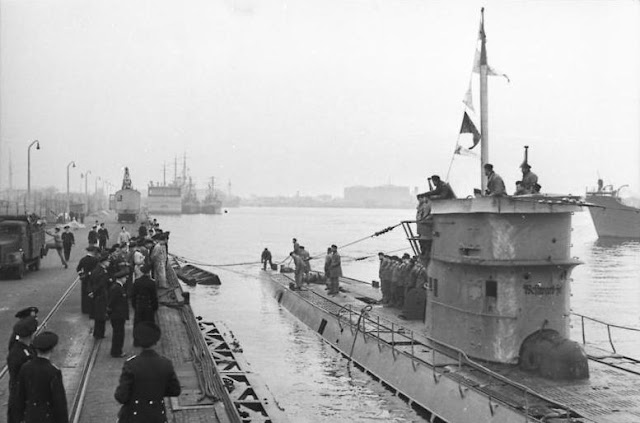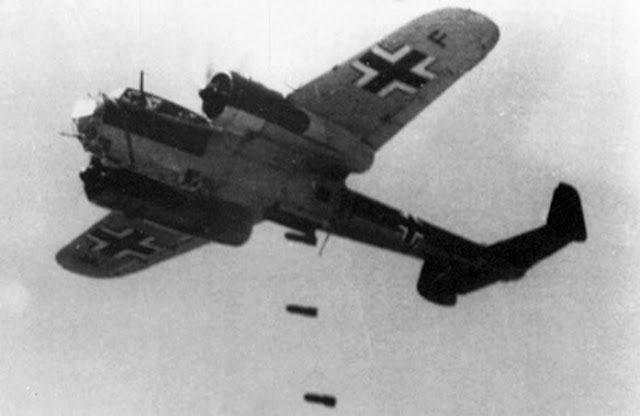Friday 26 April 1940
 |
| Fire in Voss, Norway after the bombing of 23 and 24 April 1940. Much of the wooden center of town burns. The Germans occupy Voss on 26 April 1940. |
While the whole shipment weighs 49 tons, it is to be shipped beginning on 26 April 1940 in smaller chunks to minimize the risk of loss. The first chunk, 8 tons, is loaded onto the cruiser HMS Galatea on the night of 25/26 April and shipped to England. With it goes Norwegian Director of Shipping Oyvind Lorentzen, who is to arrange for the Norwegian merchant fleet to be placed at the Allies' disposal.
The British War Cabinet, unlike the Supreme Allied War Council, is facing reality. It contemplates evacuating Namsos and Åndalsnes. General de Wiart agrees and declines the offer of additional troops: “in case of evacuation, this would complicate matters.” Everyone starts thinking about evacuation, and it becomes the common wisdom that all that is left to do is arrange an orderly evacuation.
Norway Army Operations: The British 15th Infantry Brigade begins the day defending its positions of the 25th at Kvam in the Gudbrandsdal. It has been a rare night when the Allies didn't have to retreat. Hopes soar on the Allied side. Norwegian CinC General Ruge issues a heroic Order of the Day:
"now the time of retreat has come to an end…, Stand fast … and the victory will be ours !"The Germans of the 196th Infantry Division under General Pellengahr attack again in the morning, supported by their remaining armored vehicles, artillery, and heavy machine guns. The British hold the line through the day but sustain steady losses.
At dusk, General Paget orders a retreat in the direction of Dombås to preserve his fighting force. Kvam itself is a wreck, with fires everywhere, and three civilians perish along with 50 British soldiers and four Norwegian soldiers. German casualties are similar, but they are left in possession of the field of battle. The British set up a new, temporary line 3 km back, at Kjorem.
The German 3rd Mountain Division troops at Narvik have been largely cut off from their supplies throughout the campaign. Today, some rations, medical supplies, and a few specialized personnel arrive by train via Sweden.
The Germans enter Voss after the Luftwaffe devastated it.
Norway Air Operations: The Luftwaffe bombs the British base at Åndalsnes on the personal orders of Hitler, who is furious with reports of the British 15th Infantry Brigade getting through there. He wants the Luftwaffe to "raze: the town. The handful of Gloster Gladiators which have flown to Stetnesmoen get into the air one more time to shoot down one of the attacking Heinkel He 111s, but they are running out of fuel and ammunition. Burning their craft, the airmen board ships at Åndalsnes.
The Luftwaffe attacks on the port are effective. They destroy the wooden pier and piles of British equipment and ammunition.
The Luftwaffe sinks Norwegian torpedo boat Garm.
Battle of the Atlantic: U-13 (Max-Martin Schulte) torpedoes and sinks 1,281-ton Danish freighter Lily north of Scotland at 01:17. All 24 crew perish.
Royal Navy warships off Norway sink German vessel Schiff 37, which is disguised as a Dutch ship.
Convoy OB 137 departs from Liverpool. Convoy OG 27 forms at Gibraltar. Convoy HG 28F departs from Gibraltar. Convoy HX 38 departs from Halifax.
Anglo/Swiss Relations: The British and Swiss conclude a trade agreement. The Germans have been extremely respectful of Swiss neutrality so far, just as in World War I.
British Homefront: With the recent news of higher taxes and other higher government fees, the public begins quietly re-allocating its resources. Prices of UK antiques are up dramatically since September, and the current joke is that foreign collectors "hope to buy up Britain cheap before Hitler gets it." Likewise, UK silver, art, rare books and gems are in great demand; fearful of wartime taxation and inflation, the rich are buying small, portable, concealable wealth rather than keeping their wealth in cash assets which can be taxed or seized.
 |
| Nuestro Pueblo artist Charles Owens draws a full-page map on the war in Norway which appears in the LA Times, 26 April 1940. |
April 1940
April 1, 1940: Weserubung is a GoApril 2, 1940: British Subs On Alert
April 3, 1940: Churchill Consolidates Power
April 4, 1940: Missed the Bus
April 5, 1940: Mig-1 First Flight
April 6, 1940: Troops Sailing to Norway
April 7, 1940: Fleets At Sea
April 8, 1940: HMS Glowworm and Admiral Hipper
April 9, 1940: Invasion of Norway
April 10, 1940: First Battle of Narvik
April 11, 1940: Britain Takes the Faroes
April 12, 1940: Germans Consolidate in Norway
April 13, 1940: 2d Battle of Narvik
April 14, 1940: Battle of Dombås
April 15, 1940: British in Norway
April 16, 1940: Germans Cut Norway in Half
April 17, 1940: Trondheim the Target
April 18, 1940: Norway Declares War
April 19, 1940: Dombås Battle Ends
April 20, 1940: Germans Advancing in Norway
April 21, 1940: First US Military Casualty
April 22, 1940: First British Military Contact with Germans
April 23, 1940: British Retreating in Norway
April 24, 1940: British Bombard Narvik
April 25, 1940: Norwegian Air Battles
April 26, 1940: Norwegian Gold
April 27, 1940: Allies to Evacuate Norway
April 28, 1940: Prepared Piano
April 29, 1940: British at Bodo
April 30, 1940: Clacton-on-Sea Heinkel
2019







